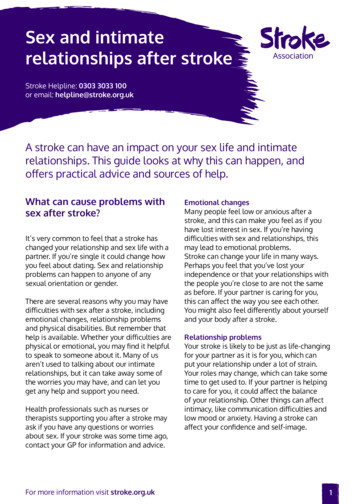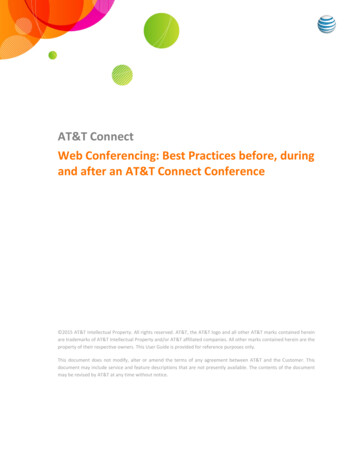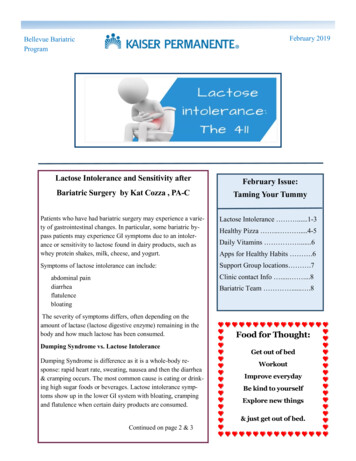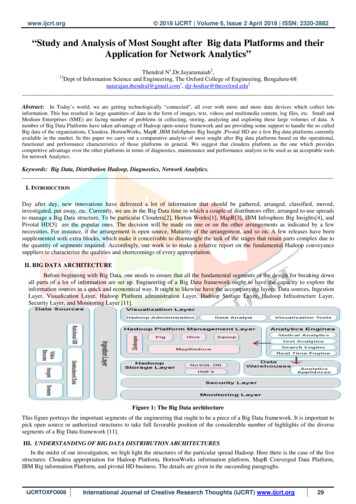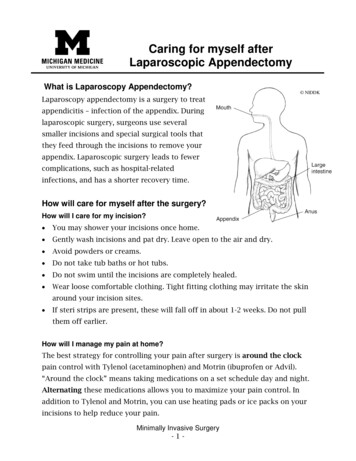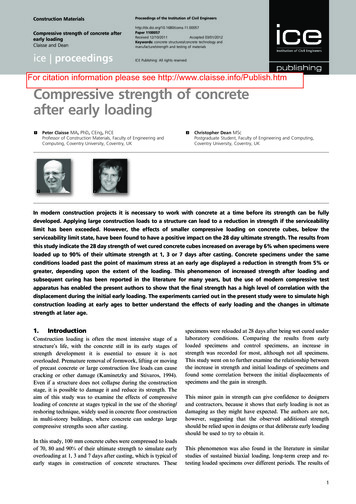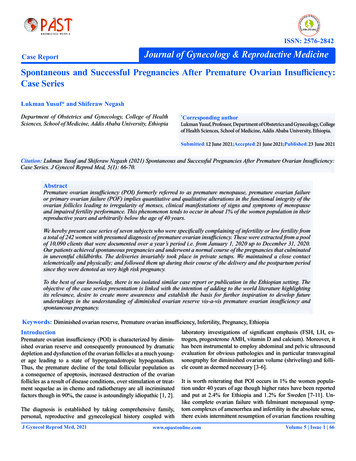
Transcription
ISSN: 2576-2842Case ReportJournal of Gynecology & Reproductive MedicineSpontaneous and Successful Pregnancies After Premature Ovarian Insufficiency:Case SeriesLukman Yusuf* and Shiferaw NegashDepartment of Obstetrics and Gynecology, College of HealthSciences, School of Medicine, Addis Ababa University, EthiopiaCorresponding author*Lukman Yusuf, Professor, Department of Obstetrics and Gynecology, Collegeof Health Sciences, School of Medicine, Addis Ababa University, Ethiopia.Submitted: 12 June 2021; Accepted: 21 June 2021; Published: 23 June 2021Citation: Lukman Yusuf and Shiferaw Negash (2021) Spontaneous and Successful Pregnancies After Premature Ovarian Insufficiency:Case Series. J Gynecol Reprod Med, 5(1): 66-70.AbstractPremature ovarian insufficiency (POI) formerly referred to as premature menopause, premature ovarian failureor primary ovarian failure (POF) implies quantitative and qualitative alterations in the functional integrity of theovarian follicles leading to irregularity of menses, clinical manifestations of signs and symptoms of menopauseand impaired fertility performance. This phenomenon tends to occur in about 1% of the women population in theirreproductive years and arbitrarily below the age of 40 years.We hereby present case series of seven subjects who were specifically complaining of infertility or low fertility froma total of 242 women with presumed diagnosis of premature ovarian insufficiency. These were extracted from a poolof 10,090 clients that were documented over a year’s period i.e. from January 1, 2020 up to December 31, 2020.Our patients achieved spontaneous pregnancies and underwent a normal course of the pregnancies that culminatedin uneventful childbirths. The deliveries invariably took place in private setups. We maintained a close contacttelemetrically and physically; and followed them up during their course of the delivery and the postpartum periodsince they were denoted as very high risk pregnancy.To the best of our knowledge, there is no isolated similar case report or publication in the Ethiopian setting. Theobjective of the case series presentation is linked with the intention of adding to the world literature highlightingits relevance, desire to create more awareness and establish the basis for further inspiration to develop futureundertakings in the understanding of diminished ovarian reserve vis-a-vis premature ovarian insufficiency andspontaneous pregnancy.Keywords: Diminished ovarian reserve, Premature ovarian insufficiency, Infertility, Pregnancy, EthiopiaIntroductionPremature ovarian insufficiency (POI) is characterized by diminished ovarian reserve and consequently pronounced by dramaticdepletion and dysfunction of the ovarian follicles at a much younger age leading to a state of hypergonadotropic hypogonadism.Thus, the premature decline of the total follicular population asa consequence of apoptosis, increased destruction of the ovarianfollicles as a result of disease conditions, over stimulation or treatment sequelae as in chemo and radiotherapy are all incriminatedfactors though in 90%, the cause is astoundingly idiopathic [1, 2].The diagnosis is established by taking comprehensive family,personal, reproductive and gynecological history coupled withJ Gynecol Reprod Med, 2021laboratory investigations of significant emphasis (FSH, LH, estrogen, progesterone AMH, vitamin D and calcium). Moreover, ithas been instrumental to employ abdominal and pelvic ultrasoundevaluation for obvious pathologies and in particular transvaginalsonography for diminished ovarian volume (shriveling) and follicle count as deemed necessary [3-6].It is worth reiterating that POI occurs in 1% the women population under 40 years of age though higher rates have been reportedand put at 2.4% for Ethiopia and 1.2% for Sweden [7-11]. Unlike complete ovarian failure with fulminant menopausal symptom complexes of amenorrhea and infertility in the absolute sense,there exists intermittent resumption of ovarian functions resultingwww.opastonline.comVolume 5 Issue 1 66
in normal ovulation and spontaneous pregnancy in about 5-10%worldwide and 2.3% of the women in Ethiopia with POI [10, 12].The conservative and prospective treatment approach would ideally be to anticipate for a spontaneous resumption of the normalovarian activity with an ultimate chance or occurrence of a pregnancy. However, for the nulliparous, infertile or of low fertilitywomen who are in dire desperation to achieve a pregnancy andhave their own children, a multitude of interventions comprisingof prepubertal ovarian tissue cryopreservation, donor egg, hormone replacement therapy (HRT), clomiphene citrate challengetest (CCCT), Dehydroepiandrosterone (DHEA), IVF (In Vitro Fertilization) and ovulation induction modalities are available whenfeasible economically and/or at last resorting to adoption. Moreimportantly, patients with such clinical disorders require psychosocial and psychosexual support to bring them out of the associated health impairment in conjunction with treatments for relatedmedical untoward effects of hypergonadotropic and hypogonadism state [2].otherwise these factors were of pertinent relevance to the presentation, they would not be further elaborated upon since they aretotally lacking.The specific laboratory investigations that were carried out toestablish the diagnosis of POI included the fertility panel (FSH,LH, estrogen, progesterone, prolactin and testosterone) and AMHwhich were very strongly implicated in cementing the diagnosisof POI. Vitamin D influences fertility; and along with calcium improves fertility and pregnancy outcomes and hence both were studied. These investigated parameters were considered fair enoughfor such a low resource setting like ours. The additional tests likefasting blood sugar, thyroid function tests, hepatitis B and C virusantibody, tests for syphilitic acquisitions and Human Immune-deficiency Virus infections were unremarkable and did not warrantany causal relationship. The abdomino-pelvic ultrasound evaluations were routinely ordered to rule out gross pelvic pathologieswhereas the transvaginal ultrasound studies mainly focused on theexclusion of polycystic ovaries, appreciation of the shrinkage ofovarian volume or, if any, the number of antral follicles.In so far as there are no published reports and short of our mentionin our previous publication on POI, the purpose of this presentation is to assert the fact that such a clinical phenomenon is not arare occurrence and create awareness among the practicing youngobstetrician-gynecologists, and contribute to the field from ourperspective in an Ethiopian setup.Synopsis of their PresentationCase SeriesGeneral RemarksE T, a housewife, aged 37 years old government employee whowas married four years ago and encountered four spontaneousabortions at 2 twice, 3 and 5 months of pregnancy, respectively.She started to experience irregular menses with up to six month’sinterval a year and half ago with minimal vasomotor symptomsand failure to achieve a clinical pregnancy.The clients constituting the case series at the Yehuleshet HigherClinic, Gyn-Obs unit were previously menstruating and becameamenorrhoic for more than three or more months or were complaining of oligo-amenorrhea and more often of infertility and lowfertility excluding cases with primary amenorrhea and/or chromosomal abnormalities. Their menarche was invariably between ages11-16 years. Their age range spanned from 33 to 38 years and theaverage years thus computed was 35. They accounted for a 2.4%(242/10,090) prevalence rate of POI among the patient populationseen in the stated period of time; and yielded a 2.9% (7/242) successful spontaneous pregnancy rate after clinically confirmed premature ovarian insufficiency. Their data was collected from January 1 to December 31, 2020. They are residents of Addis Ababawith the exception of one from its vicinity. They were all followedup for the first four months of 2021 to wrap up the data compilation, proceed with the analysis and finalize the write up.The data extracted from their history included the socio-demographic information, presenting complaints and their associatedsymptom complexes, family history and elaborate medical, inparticular autoimmune disorders, chemotherapy and radiotherapyfor gynecological or colorectal cancers, and surgical anamnesis(bilateral oophorectomy) pertaining to possible and contributingelements towards aetio-pathologic processes of POI. Unless andJ Gynecol Reprod Med, 2021The individual brief description of the background history uponthe initial presentation and prior to their success story of achievingadditional, unexpected and successful spontaneous pregnancy andchildbirth is illustrated hereunder.1. Case 1 (1993/11)2. Case 2 (623/09)W A is a 32 years old housewife and a primipara with a normalvaginal delivery 3 years ago. She complained of oligo-amenorrhea of two year’s duration and failure to attain a renewed pregnancy. The associated vasomotor and decreased libido as well asdisharmony with the husband was annoying and threats of divorcewere looming. This became more pronounced with the surge oftheir financial and material wealth.3. Case 3 (1093/06)A K is 33 years old Para II Abortion II. She a banker by professionand presented with amenorrhea of six months, hot flushes, sweating, mood swings, sleeplessness and decreased libido as well asstrong desire to have a child in fulfillment of the husband’s strongdesire.4. Case 4 (2013/11)E G is a 38 years old nulliparous with three consecutive and spon-www.opastonline.comVolume 5 Issue 1 67
taneous abortions of less than three months of gestational ages.She is a government employee who presented with oligo-amenorrhea spanning up to 3-6 months and ineptitude to achieve a viableterm pregnancy.ner’s pressure forced her seek medical help to abate the symptoms,improve on their sexual relationship and demandingly have morechildren.5. Case 5 (429/12)S F is 35 years old self employed merchant, Para II Abortion 0.Her last delivery was 5 years ago and presented with complaints ofunpredictable menstrual patterns with intervals longer than threemonths and menopausal symptoms; and inability to have morechildren.B A is a 33 years old, Para 0 Abortion II. She is self employedfrom the vicinity of Addis Ababa and presented with complaintsof irregular menses with intervals of more than three months andmore importantly failure to procure a term pregnancy that climaxin live childbirth.6. Case 6 (265/05)T N is 39 years old Para III Abortion 0. She is a banker by profession and presented with amenorrhea of 6 months and fulminantsigns and symptoms of postmenopausal syndrome. The male partVariablesFertility nAMHVitamin DSerum calciumCase l of our patients were counseled on the available provisions ofART. In the light of financial constraints and the improbability ofgetting the required advanced comprehensive treatment outsidethe country, they are hinted that pregnancies can still happen. Alternatively, they were all voluntarily put on folic acid, vitamin Dand calcium supplementation without coercion or inducements.Whenever the unexpected and spontaneous pregnancies were suspected and confirmed, they were electively put on oral 10 mg dydrogesterone therapy in combination with weekly 250mg 17-a-hydroxyprogesterone-caproate (17-OHPC) depot injections for up to14 weeks of pregnancy as a prophylaxis in the prevention and lowering of the risk of miscarriage thereby ensuring the maintenanceof the pregnancy and also achieve the quiescence of the uterus.The normal spontaneous fertility performance of women and thenumber of individual reproductive years is very much dependenton the physiological synchronization of the function of the pituitary gland (FSH, LH) with the ovarian reserve, production of estrogen and progesterone with the cyclical and natural release of amature Graafian follicle. Furthermore, these qualities and their reJ Gynecol Reprod Med, 2021Selected and Specific ResultsThe essential laboratory investigations that were employed andcontributed to the basis of the diagnosis of POI are tabulated andpresented in the following .80Management ApproachDiscussion7. Case 7 /mlng/mlmg/mlsponsiveness to stimulation are fully and meaningfully expressedprovided that the axis pertaining to the fallopian tubes, uterus andthe vaginal tract is intact and functional [13]. Our clients were normally menstruating, engaged in normal sexual activity and werecapable of becoming pregnant as evidenced by their parity andhistory of miscarriages up until the onset of the POI.The hallmark of the presentation of POI is more importantly distinguished by the low fertility or infertility. The diagnostic measures employed, especially the fertility panel and AMH, are explicit tools to basically establish the diagnosis of idiopathic POIin a low resource setting. As opposed to subjects with primaryamenorrhea as in congenital disorders like Fragile or Turner’ssyndrome, or those who underwent bilateral oophorectomy and/orwere subjected for chemo-radiation for cancer treatment or havehad history of pelvic infections, endometriosis and autoimmunedisorders resulting in absolute ovarian failure, patients with POIas in our presentation, can unpredictably get pregnant without anyintervention [14].The possibility of such an event which is in the range of 5-10%worldwide and a 2.3% rate in our earlier publication and 2.9% inwww.opastonline.comVolume 5 Issue 1 68
our current study is strikingly a matter of concern as our results areof low percentages which can be attributed to drop outs in favor ofindividual preferential medical or traditional treatment modalitiesor lost to follow ups in general. At this juncture, it is worth speculating that previous reproductive performances, family history,genetic and environmental factors, socio-economic influences andnutritional disadvantages may exert their negative detrimental effect.LimitationsThe chances of a successful spontaneous pregnancy, no matterhow remote, are always thoroughly discussed as a mandatorycounseling process from and in line with reproductive rights perspective [10, 15-17]. Furthermore, in order to alleviate their feeling of hopelessness and despair, management options that includehormone replacement therapy, donor egg and IVF within the scopeof ART, if affordable and acceptable by travelling abroad, were putforth for them and advised to never give in or give up despite thebothersome vasomotor and neurovegetative symptoms, if time isof the essence to primarily overcome their infertility issue ratherthan the low fertility related desire.We are grateful and indebted to all colleagues who were interestedand encouraged us to collect such cases to document and eventually publish it as a follow up of our previous publication on POI.Our special appreciation goes to Sr Kalkidan Berihun for shelvingthe cards separately and producing them upon their every visit andavailing them for the completion of the write up.Therefore, in a high parity population like ours, the cultural desire to have more children is rather governed by the male partner,relatives or clans, their religious or mystic beliefs and the common concept that the child is born with its bounty and that thereis no limit for procuring a child. The failure to do so results in anemotional trauma with sullen faces and desperation; and at timesthreats of possible divorce or separation. More often, our patientsinitially go into a denial state during counseling and express a displaced anger and vow to resort to unspecified traditional medicines, religious practices including holy water baths and drinking.As a part of our counseling, we routinely and emphatically differentiated our earthly knowledge from the unexpected miraculousgodly surprises or provisions of nature in the glimmer of hope thatpregnancy can still occur without intervention despite the diagnosis of POI. It is thus imperative to enlighten academicians andpractitioners alike in the understanding of the clinical entity andthe complexity of its management.Conclusion and RecommendationPremature ovarian failure (POF) or premature menopause impliesabsolute/ cessation of menses, failure to ovulate and present withovert clinical manifestations of symptom complexes of menopause. POI patients, however, can resume menstruating, ovulateintermittently, get pregnant unexpectedly and deliver as demonstrated in these case series and also corroborated in other such publications. It is apparent and commendable to co-opt of standardizedset of criteria to diagnose and manage the clinical entity as tailoredtowards the individual need. Moreover, it is worth contemplatingto undertake such a longitudinal prospective study in the future byinterested groups or individuals in multicenter setups involving alarger segment of the population.J Gynecol Reprod Med, 2021This is just a case series presentation and no significant predictivescoring system to determine ovarian activity, as in the Swedishstudy involving a larger population composed of 358 patients, wasadopted. The main variables of relevance that they accounted forincluded age at diagnosis, presence of follicles at ultrasound, inhibin b, and estradiol levels .11.12.13.Gleicher N, Weghofer A, Oktay K, Barad D (2009) "Do etiologies of premature ovarian aging (POA) mimic those of premature ovarian failure (POF)?" Hum. Reprod. 24: 2395-2400.Nelson LM (2009) Clinical practice. Primary ovarian insufficiency. N Engl J Med. 360: 606-614.Goswami D, Conway GS (2005) Premature ovarian failure.Hum Reprod Update. 11: 391-410.Taylor AE (2001) Systemic adversities of ovarian failure JSoc Gynecol Investig 8: S7-S9.G Méduri, N Massin, J Guibourdenche, A Bachelot, O Fiori, et al. (2007) Serum anti- Müllerian hormone expressionin women with premature ovarian failure. Hum. Reprod 22:117-123.Ilse A J van Rooij, Frank J M Broekmans, Gabrielle J Scheffer, Caspar W N Looman, J Dik F Habbema, et al. (2005) Serum anti Müllerian hormone levels best reflect the reproductive decline with age in normal women with proven fertility: alongitudinal study. Fertil. Steril 83: 979-987.Coulam CB, Adamson SC, Annegers JF (1986) Incidence ofpremature ovarian failure. Obstet Gynecol 67: 604-606.Torrealday S, Kodaman P, Pal L (2017) Premature ovarianinsufficiency - an update on recent advances in understanding and management version 1. F1000Res. 6: 2069. doi:10.12688/f1000research.11948.1Rebar RW (2009) Premature ovarian failure. Obstet Gynecol113: 1355-1363.Lukman Y, Shiferaw N (2020) Premature ovarian insufficiency. Gynecol Reprod Health 4: 1-9.Lagergren K, Hammar M, Nedstrand E, Bladh M, Sydsjὃ G(2018) The prevalence of primary insufficiency in Sweden; anational register study BMC Women’s Health 18: 175The American College of Obstetricians and Gynecologists,Committee on Adolescent Health Care (2014) Committeeopinion no. 605: primary ovarian insufficiency in adolescentsand young women. Obstet. Gynecol 124: 193-197.Testing and interpreting measures of ovarian reserve: a committee opinion (2012) Practice Committee of the Americanwww.opastonline.comVolume 5 Issue 1 69
Society for Reproductive Medicine. Fertil Steril 98: 14071415.14. Gu Y and Xu Y (2020) Successful Spontaneous Pregnancyand Live Birth in a Woman with Premature Ovarian Insufficiency and 10 Years of Amenorrhea: A Case Report. Front.Med. 7: 18.15. Vandborg M, Lauszus FF (2006) Premature ovarian failureand pregnancy. Arch Gynecol Obstet 273: 387-388.16. Chen FP, Chang SY (1997) Spontaneous pregnancy in patients with premature ovarian failure. Acta Obstet GynecolScand 76: 81-82.17. Vital-Reyes V, Tellez-Velasco S, Chhieng D, Grizzle W,Reyes-Fuentes A (2004) Spontaneous pregnancy in a womanwith premature ovarian failure: a case report. J Reprod Med49: 989-991.18. Maud Bidet, Anne Bachelot, Estelle Bissauge, Jean LouisGolmard, Solenne Gricourt, et al. (2011) Resumption of ovarian function and pregnancies in 358 patients with prematureovarian failure. J Clin Endocrinol Metab 96: 3864-3872.Copyright: 2021 : Lukman Yusuf. This is an open-access articledistributed under the terms of the Creative Commons Attribution License,which permits unrestricted use, distribution, and reproduction in anymedium, provided the original author and source are credited.J Gynecol Reprod Med, 2021www.opastonline.comVolume 5 Issue 1 70
Spontaneous and Successful Pregnancies After Premature Ovarian Insufficiency: Case Series Case Report . strong desire to have a child in fulfillment of the husband’s strong desire. 4. Case 4 (2013/11) E G is a


